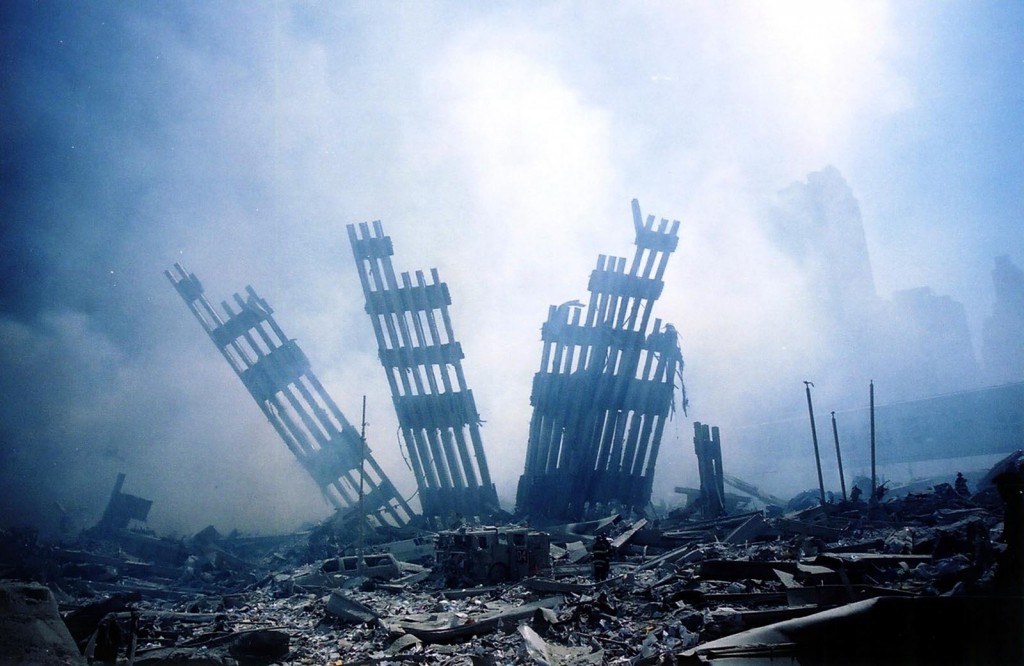The False Flag 9/11 Attacks Reportedly Done By A Israel Zionist Connection Is Still Killing People
Another Opinion
Thousands Have Cancer, Hundreds are Dead from a Massive Chemical Attack On Americans
Asbestos. Though you’re likely familiar with the insidious minerals used in fireproofing and a number of other applications, first responders to the September 11 attacks on the World Trade Center and residents in the area know intimately the dangers it can pose.
Once you’ve breathed in even a single fiber of asbestos — a “known human carcinogen” — you’re theoretically at risk for developing cancer, asbestosis, mesothelioma, and more. Though the National Cancer Institute states “[e]veryone is exposed to asbestos at some time during their life,” repeated or sustained exposure poses the greatest risk. And it specifically lists first responders to 9/11, volunteers who helped during the aftermath, and residents “in close proximity” to the site as having documented health effects from asbestos and other unknown toxins released into the air that day.
In recent days, there has been much discussion concerning responsibility for Saudi Arabia’s alleged role in the attacks — and the possibility the kingdom’s involvement may be divulged should Pres. Obama release the ‘missing’ 28 pages from the 9/11 files. But what hasn’t been discussed is the lack of or limited accountability by the United States government in caring for peripheral victims who continue to suffer — and die from — exposure to asbestos and other toxins.
As Luke Rudowski, founder of We Are Change — who was living in the path of the toxic particulate miasma that day — explained in a new video, the government’s shirking of responsibility could easily be called “criminal.”
“In the beginning, everyone always said, ‘well, the government wouldn’t lie to us, they said that the air was safe to breathe,’ and especially living in New York City, the emotional trauma that 9/11 brought upon everyone was intensified because we were there,” Rudowski explained in an interview with The Free Thought Project about his personal experience.
I knew many people who lost loved ones and who were missing people. It was an utterly chaotic day — just utter fear controlling everyone; and because of that, everyone trusted everything the government said.
After the attacks, you were just inundated with state-run television that was just broadcasting all this tremendous fear, and when they said the air was safe to breathe, there was … really no reason for me not to believe that.
This isn’t just some far-flung theory. As Scientific American wrote on the tenth anniversary of the attacks, as also noted by Rudowski in his video, the then administrator of the U.S. Environmental Protection Agency Christie Whitman told the public on September 13, 2001, “EPA is greatly relieved to have learned that there appears to be no significant levels of asbestos dust in the air in New York City.” Adding, “We will continue to monitor closely.”
Five days later, she perpetuated the lie by reiterating firmly, “I am glad to assure the people of New York and Washington, D.C., that the air is safe to breath [sic].”
But it wasn’t.
Asbestos that had been used in the construction of the North Tower of the World Trade Center ballooned out in a putrid, toxic cloud containing untold quantities of other toxins and particulates — and has since caused illness, respiratory ailments, and fatalities in an unknown number of people present that day.
In fact, the Inspector General of Whitman’s own agency concluded two years after she’d assured people’s safety, that the EPA “did not have sufficient data and analyses to make such a blanket statement.” Of the myriad samples the EPA did collect in the weeks following the attack, 25 percent contained levels above the 1 percent “safe” threshold indicative of “significant risk.”
“Competing considerations, such as national security concerns and the desire to reopen Wall Street, also played a role in the EPA’s air quality statements,” the Inspector General noted in the report in 2003.
That deception in the interest of, essentially, the banking interests and the government quite possibly directly influenced the decisions of volunteers — firefighters, police, health workers, local residents, concerned civilians, and members of the military — to work at or near Ground Zero in the days and weeks following. Worse, as Rudowski explained, volunteers were told protective masks and gear were unnecessary — and should be removed.
“It was not just the family members [of the victims] who were getting screwed over by the government, but those who were down there helping … in the [cleanup] efforts. They were dropping dead and becoming ill; and it was swept underneath the rug, and … finally, people started talking about, ‘Hey, I was at Ground Zero and now I have lung cancer.’ Or ‘I have mesothelioma’ or ‘I have this strange disease that no doctor can classify.’ And those were the first people who were affected by it,” said Rudowski.
That’s when I saw that, yeah, the air was extremely hazardous.
Indeed, it was. According to Scientific American, the two towers had contained “heavy metals, such as lead,” “polychlorinated biphenyls (PCBs) … that are toxic on their own and become even more toxic when burned at high heat, and glass fibers that lodge in the lungs. The levels of dioxin measured in the air near the smoldering pile ‘were the highest ambient measurements of dioxin ever recorded anywhere in the world,’ levels at least 100 times higher than those found downwind of a garbage incinerator,” reported a 2007 analysis by the EPA.
“After 9/11 and during 9/11, I was in Brooklyn, directly in the path of where the wind was carrying the toxic smoke,” Rudowski continued, “so the dust was all over the street, was all over the car, all over the house, was all over … you know, everywhere. And you could write your name, like it was in the snow, on cars — but it was all the dust from 9/11.” He noted, somewhat eerily, there were “papers from the World Trade Center” that had blown into the streets — all the way across the East River, into his Brooklyn neighborhood.
Rudowski explained that though he was a teenager at the time, the attacks and subsequent cleanup effort — and mounting lies from the government surrounding the attacks — became a pivotal moment in his life. He began going to Ground Zero to hand out fliers and speak to volunteers.
People who survived the attacks and rescue workers started coming up to us and talking to us — giving us all this information about how they were told not to wear gas masks; how they were told not to put on their hazmat suits; and how their health had been utterly destroyed.
Notably, being told not to take safety precautions likely compromised the health of an untold number of people. Paul Lioy, environmental scientist with the Environmental and Occupational Health Services Institute in New Jersey — who provided samples of the pulverized dust to various government agencies after the attack — explained such safety equipment would have been crucial in preventing future ailments in first and secondary responders.
“The key is when you arrived, whether you were wearing a respirator or not, how long you were there and how high the concentrations were that could lead to effects,” he noted for the article in Scientific American. “I think people who wore respirators have a lower probability of health effects … People who came early to the site and were not wearing respirators have a greater probability of having more severe effects.”
“At that time, there was a lot of confusion, and the health effects, the illnesses, weren’t even classified — couldn’t even be classified — by many doctors,” Rudowski said. “And now they’ve opened up a special institute just for that.”
Nearly ten years after the tragedy, the National Institute for Occupational Safety and Health announced coverage for those who developed cancer from the various toxins under the World Trade Center Health Program, established when the Zadroga 9/11 Health and Safety Act was signed into law on January 2, 2011. Named for James Zadroga, an NYPD detective who spent hundreds of hours at Ground Zero before developing respiratory ailments that eventually led to his death, the Act still presents some hurdles for those affected by the toxic plume since the full spectrum of toxins released that day has never been fully evaluated.
Zadroga’s illness and resultant death became the subject of contention when, though his autopsy revealed otherwise inexplicable abnormalities, some doctors and scientists flatly refused to attribute them to his countless hours volunteering at the smoldering site. In part, they claimed, no comparison had been officially done between air and dust samples and those found in Zadroga’s lungs — but that somewhat ignores the lack of a comprehensive analysis of the massive toxic cloud and settling dust.
New York City Mayor Michael Bloomberg eagerly joined that criticism, originally saying of Zadroga in 2007, when the chief medical examiner disputed the connection between the man’s death and 9/11, “We wanted to have a hero, and there are plenty of heroes. It’s just in this case, science says this was not a hero.”
As Rudowski clarified, the controversy over the death involved the lack of treatment for excruciating pain Zadroga contended with due to his illness — eventually leading the man to crush and inject pain medicine in order to cope with everyday living. Those doctors and medical examiners who disputed his cause of death pointed to the pain medicine — not the original cause of his pain — in denying Zadroga had been ultimately killed by the events of 9/11.
After coming under intense criticism of his own for saying so, Bloomberg somewhat backtracked, stating, in part, “It’s a question of how you want to define what a hero is, and I certainly did not mean to hurt the family or impugn his reputation.”
As cruel as Bloomberg’s description of a Ground Zero volunteer might be, it reflects general governmental attitude toward rescue workers and others who may not be considered ‘direct’ victims of 9/11. They face the complex challenge of dealing with illness, establishing an ‘official’ connection between their health issues and 9/11 toxins to gain coverage under the WTCHP, and fending off both government denial and a general, prevailing attitude that their sickness must be either all psychological or that it simply could not be connected to the events of September 11, 2001.
“At first, the government said, ‘No, you can’t be sick from Ground Zero, you just have Post-Traumatic Stress Disorder.’ And all the first responders were saying, ‘No. No, this was a toxic plume. This dust was extremely dangerous and is killing a lot of us,’” Rudowski explained. “And the government straight out denied it,” he said, specifically noting Bloomberg’s effrontery statements about Zadroga. “Because there were so many people sick — about 50,000 first responders — and many of them were so sick, the medical costs were so huge, that the city said, ‘We’re not going to pay for this,’ and denied first responders even medical care under their city contracts that they’re entitled to — because they said, ‘No, this isn’t related to 9/11, it can’t be related to 9/11. You guys just have [PTSD]. You’re not really sick.’”
But according to the National Cancer Institute, one study “found that nearly 70 percent of WTC rescue and recovery workers suffered new or worsened respiratory symptoms while performing work at the WTC site.”
Rudowski and the Institute both emphasize it can take decades for the symptoms of an asbestos-related illness or cancer to manifest — and that still doesn’t encompass the myriad illnesses and deaths directly related to unknown particulates and toxins released in WTC dust.
On September 6, 2011, Mount Sinai published results of the first long-term studyof 27,000 rescue and recovery workers, which found “high incidence of several conditions, including asthma, post-traumatic stress disorder (PTSD), depression, sinusitis, and gastroesophageal reflux disease (GERD). More than one in five of all the responders studied had multiple physical and/or mental health problems.”
However, “It has never been fully documented correctly because it’s virtually impossible to keep track of so many people” involved in rescue, recovery, and cleanup of 9/11, Rudowski explained. “Regarding first responders, themselves, at Mount Sinai they did some studies … but a lot of the data is really hard to compile since we’re talking about hundreds of thousands of people.” Particularly, he notes, because New York City’s large population is constantly shifting as people move in and out all the time.
“I had friends who died from this. I had friends who suffered terribly from all these illnesses and all these horrible diseases they got because of … the dust from being down [at the site], working. And those effects will … reverberate within the next ten, twenty, thirty years — and it’s really hard to pinpoint exactly who gets what [illness] from what, when we’re talking about those time frames,” he said.
“But if you look at the effects of asbestos, and not only asbestos, but everything that was in those twin towers — those cathode ray tubes, the computers — everything was smashed to dust. Everything was obliterated.”
Last year, on the fourteenth anniversary of the attacks, consultant for the Centers of Disease Control and Prevention, Max Lum, wrote a sweeping statement regarding the health repercussions experienced by those in New York City, stating:
“It is estimated that over 400,000 people were exposed to toxic contaminants, risks of traumatic injury, and physically and emotionally stressful conditions in the days, weeks, and months following the attacks. Symptoms of 9/11 conditions include chronic cough, shortness of breath, sinus congestion, certain cancers, stress related disorders, and depression among the many other symptoms and conditions,” adding there are over 72,000 people currently enrolled in the WTCHP.
Rudowski first saw the report just days ago, which led him to the map showing the path of the toxic dust plume — and the making of the video detailing his personal experiences related to 9/11. Though he understood the dangers faced by those working the ‘pile’ at Ground Zero, Rudowski hadn’t considered the potential he could face the same prior to stumbling upon Lum’s report — and though he is concerned, he repeatedly emphasized the difficulties faced by first responders and their families.
And whatever controversies, theories, and opinions may pervade discussions about September 11, “the real story here … is the plight of the 9/11 first responders and what they had to go through.”
As the government creates obstacles to health care for those first responders, rescue workers, volunteers, and area residents and office workers facing 9/11-related illnesses and conditions, it’s up to us as a populace not to let their struggles be swept under the rug — or obfuscated for the sake of larger 9/11 controversies.
In the end, a comprehensive assessment of the number of lives affected that day — and by events, policies, and illnesses resulting from the attacks — remains impossible. But it’s imperative we don’t allow the symbolism of the towers to cloud our understanding of the very real individuals who paid the price for their being knocked down.
The Free Thought Project would like to thank Luke Rudowski for the interview and for sharing his experience.
Claire Bernish writes for TheFreeThoughtProject.com, where this article first appeared.
Reflecting Beyond the Illusions by The Truth Tale - Now Live At The Following Locations
 |
 |
 |
 |
 |
 |
 |
 |
 |
 |




